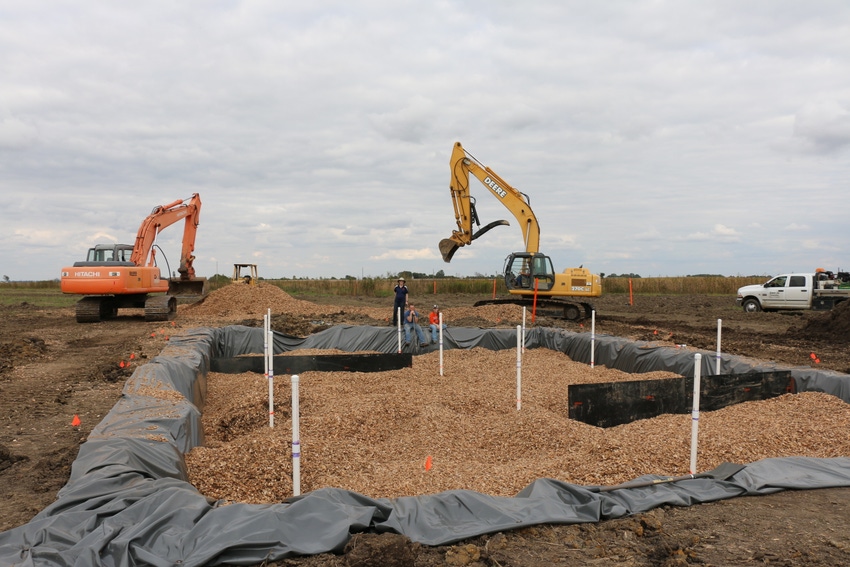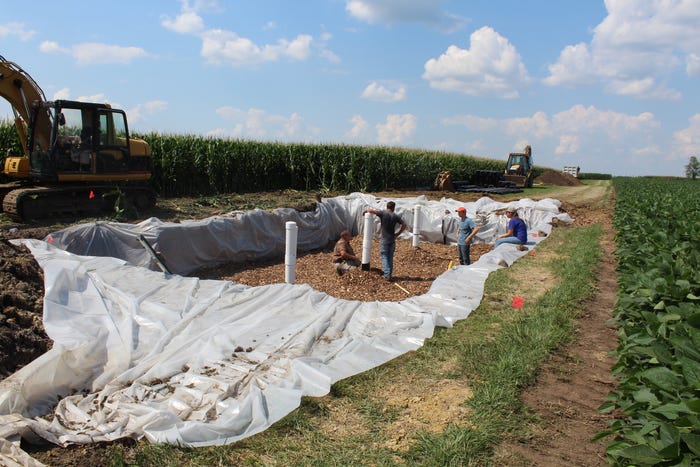
Farmers looking for a method to help reduce nitrate flow from specific fields may want to consider constructing a woodchip bioreactor. The woodchip bioreactors acts as a filter to clean the water as it flows from the tile into the surface water body. The cost is often what is on a producers mind.
Dr. Laura Christianson, Professional Engineer and Assistant Professor in the Department of Crop Sciences at the University of Illinois, presented a webinar for the Iowa Learning Farms and has been studying how bioreactors work and how farmers can benefit from them.
Bioreactors are subsurface trenches that can range from 50 feet to 120 feet long and are filled with a 3-ft. layer of woodchips through which water is allowed to flow just before leaving the drain to enter a surface water body. The trench can help remove nitrates from 35 acres to 50 acres depending on the length and depth of the bioreactor. Research has found that the longer and narrow a bioreactor is determines the efficiency. The carbon source in the trench serves as a substrate for bacteria that break down the nitrate through denitrification. The tile lines are tied into one or two control structures depending on the design. The control structures serve the coming and going of the water into the bioreactor.

DCIM109MEDIADJI_0721.JPG
The key to ensure the woodchips can remove the nitrates is the water retention time. Research shows that six hours minimum is required to get the most effective removal of nitrates. If the water is moving too fast then the conditions for denitrification will not work. Several factors matter when it comes to how effective the bioreactor works. One factor is the porosity of the woodchips, the volume of the water through the bioreactor (it can be controlled though design), flow rate and the hydraulic retention time.
Bioreactors work by using the natural process of denitrification The denitrifying bacteria colonize the woodchips. The carbon in the woodchips is used to fuel respiration. In other words, the bacteria eat the carbon.
The good news is bioreactors can range in cost. On average, a bioreactor will cost $10,000 for about 50 acres of drainage. The cost can run anywhere from $3,000-$25,000 depending on the size and what a producer has in mind.

Christianson said a farmer in Illinois built a bioreactor this summer (2017) and it cost him $3,000 to drain 35 acres because he did the excavation himself, had his own farm labor to do the work and had the woodchips available to him free of charge (although they weren’t necessarily the best woodchips). However, another farmer on the east coast used a design firm and his project cost $25,000 to drain 60 acres.
Woodchip size matters
Several factors involving the woodchips placed in the trench do matter when it comes to the bioreactor effectiveness. One area that impacts how well the bioreactor works is whether or not chips are used. It was discovered that chips with a size of a one-half-inch to two inches must be used. It is not recommended that shreds or mulch be used and no leaves, needles and bark.
Researchers also found that the percent of nitrate load being reduced is not impacted by the type of wood used—this means that either hardwood or softwood can be used for the chips in the bioreactor.
Water temperature reduces effectiveness
Christianson’s research has found that the temperature of the water flowing through the bioreactor can have an impact. Annually, a bioreactor can remove 25-45% of the nitrates.
However, when the temperature drops below 43 degrees F, nitrate removal drops to less than 30%.
Longevity of a bioreactor
Research has found that as bioreactors age, effectiveness declines. Christianson found that reactors less than 13 months old had a higher efficiency to lower the nitrate loads. A bioreactor’s lifespan normally runs between 7 and 15 years. And it’s not the woodchip carbon source that determines the effectiveness of the bioreactor but the water flow. A change in flow or pattern of how the water flows through the tile lines can impact how long the bioreactor is active.
For additional details on bioreactors, check out these links:
http://agwatermgmt.ae.iastate.edu/content/denitrifying-woodchip-bioreactors
About the Author(s)
You May Also Like




